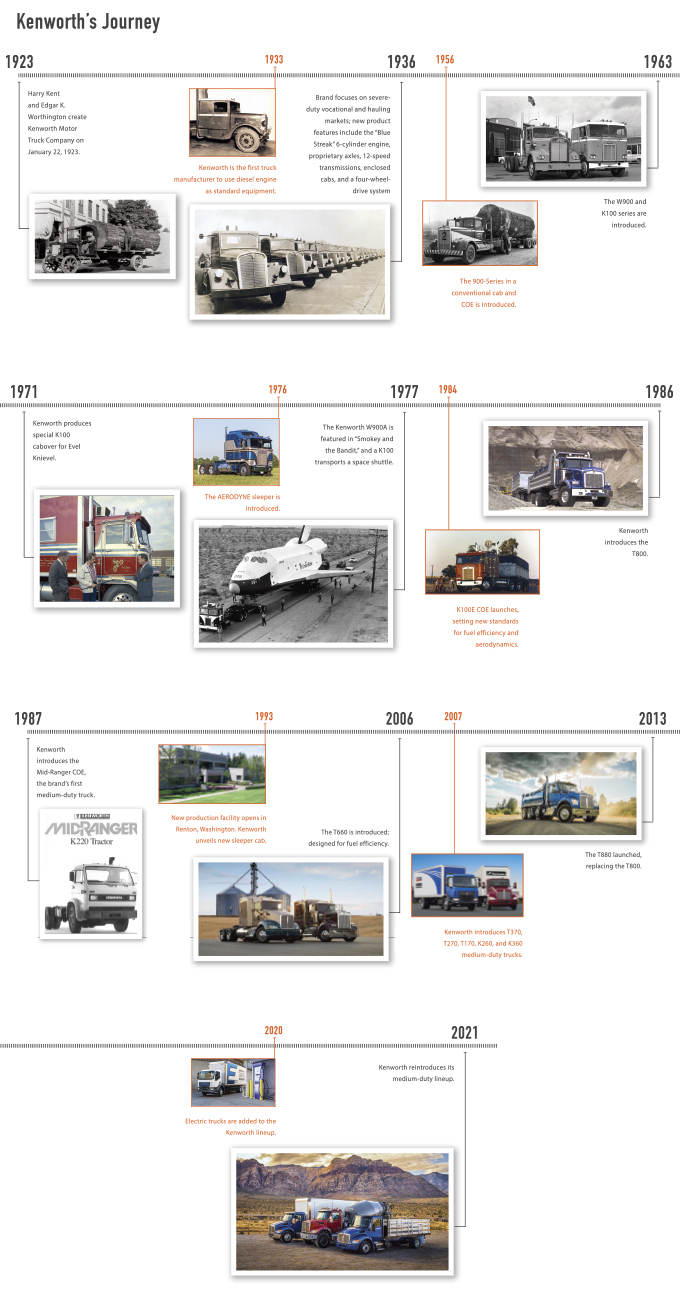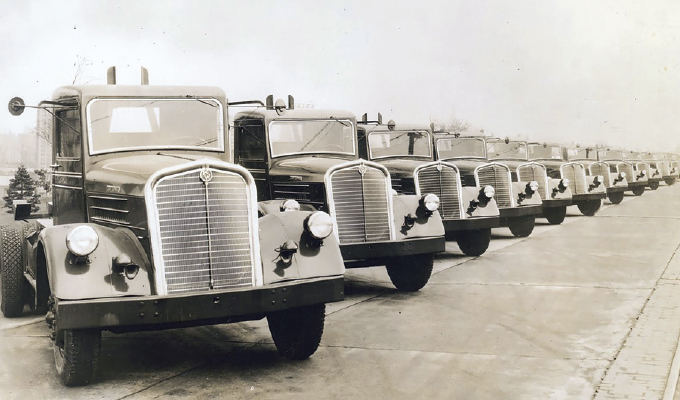The year was 1923. The logging industry in the Pacific Northwest was booming. Harry Kent and Edgar K. Worthington sought to find a way to more efficiently move heavy loads down winding, narrow, and muddy logging roads. By March of that year, a new truck rolled off the assembly line bearing the combined name of the two men, “Kenworth.”
In 1927, Kenworth opened a 120-ft by 240-ft factory in Seattle, manufacturing 50 trucks per month. The company also delivered its first Canadian-assembled truck, the J-6, in this year. By the 1930s, Kenworth produced 250 trucks per year, expanding its reaches into the fire truck market.
AN INDUSTRY PIONEER
It’s hard to imagine a world where diesel engines weren’t the top choice for heavy-duty trucks, but without Kenworth’s pioneering, perhaps it wouldn’t have happened. In 1933, Kenworth began installing diesel engines as standard equipment. The first diesel-equipped trucks were also the first in the industry to have vertical exhausts along with a 4-cylinder, 100 hp HA-4 Cummins engine.
The pioneering didn’t stop at the powertrain, however. Kenworth was also the first to integrate a sleeper cab into its trucks. Further, when weight restrictions and bridge laws took effect, Kenworth was also one of the first to begin using aluminum in its truck components.
In 1936, truck restrictions in Mexico led to more Kenworth innovation. The country allowed more weight on the axles, but restricted truck length to 45-ft. As a result, the first cab-over-engine (COE) truck was born, Kenworth’s Model 516.
During World War II, Kenworth stalled production of trucks used for vocational purposes and shifted to military vehicles. These years allowed Kenworth to perfect and further innovate with its use of aluminum, leading to yet another first with the production of the first aluminum frame on a Kenworth truck.
TRUCK INNOVATION
Many trucks have come down the assembly line in Kenworth’s 100 years—well over 1 million to be more precise. Throughout the years, Kenworth has innovated its way to its current lineup, first introducing its popular K and W series trucks in 1963, named after the original Kenworth founders. In 1985, Kenworth introduced the T600A, featuring an aerodynamic design that resulted in a truck that was 20% more fuel efficient than the Kenworth W900. The next year, Kenworth introduced the T800, which became popular in the construction, pickup, delivery, and extreme long-haul industries. Kenworth solidified its three-peat years of innovation in 1987, introducing its first medium-duty truck, the Mid-Ranger COE.
Through the late-1980s and early-1990s, Kenworth continued to expand its truck lineup, improving the design of its truck for both efficiency and comfort. Some of these improvements include aerodynamic features and the introduction of the largest sleeper cab on the market.
In 1994, Kenworth introduced a conventional cab medium-duty truck, the T300. Kenworth based the T300’s design on its Class 8 trucks, resulting in a durable medium-duty truck.

BIG TRUCKS, BIG SCREEN
Not only is the Kenworth brand well-known among drivers and fleet owners, it’s also well-known in Hollywood.
Is there any big truck more famous than the Kenworth W900A featured on “Smokey and the Bandit”? We all saw that truck on the big screen, but it wasn’t actually the first Kenworth to have a spotlight. Three years prior to the release of “Smokey and the Bandit” in 1974, a Kenworth W925 was featured on the television drama “Movin’ On,” which ran for two seasons. Hollywood proved its love of the brand yet again in 1979, featuring a Kenworth K100C AERODYNE in the show “B.J. and the Bear.” Finally, in 2000, a Kenworth T2000 Advanced Technology was featured in the series “18 Wheels of Justice.”
THE DRIVER’S TRUCK
Although seeing a Kenworth on the screen is exciting, Kenworth owners don’t purchase their trucks because Smokey looked cool driving it. They purchase these trucks because of the design and heart Kenworth’s engineers put into their trucks.
Kenworth’s motto from the days of old have rang true throughout the decades. The motto was born not from a sentiment, but an action. “Kenworth engineers wear muddy boots” was an accurate statement, as the company’s engineers ventured into the field to troubleshoot issues, problem-solve, and continually hunt for a better way to design a truck. And that’s why Kenworth has been a pioneer in the industry for a century—solving problems that other engineers might not have known about because they didn’t get their boots dirty.
Kenworth isn’t known by that exact motto today, but it is known for building the “driver’s truck”—a truck that can tackle all the hard jobs, but all while keeping the driver comfortable, safe, and efficient. Here’s to 100 more years of pioneering and innovation.

FOR MORE INFORMATION
Find out more about Kenworth’s 100 years of innovation, visit www.kenworth100.com.




